By Gill Stewart at
We know it can be daunting to take up exercise if it has never been a habit or things have lapsed due to a busy lifestyle. However, it is NEVER too late to make some positive changes that will make a huge difference to your later years.
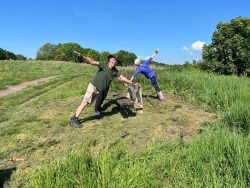 We are not talking running miles a day or tough gym sessions – just moving more and taking time to move your body in ways that will keep it strong, flexible and energised. Even if you have noticed a decline in your mobility, strength or balance, there are simple things you can do to make improvements and stop the decline …..at any age!
We are not talking running miles a day or tough gym sessions – just moving more and taking time to move your body in ways that will keep it strong, flexible and energised. Even if you have noticed a decline in your mobility, strength or balance, there are simple things you can do to make improvements and stop the decline …..at any age!
Age UK have produced some great resources aimed at those in their 50’s to help get this message out there. See their Act now Age better campaign HERE
Why?
The research is clear that being more active can reduce the risk of:-
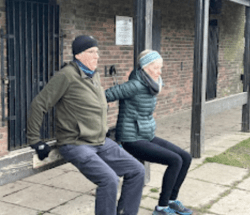 It also leads to better balance, fewer falls and greater independence in older age.
It also leads to better balance, fewer falls and greater independence in older age.
Thats why at WALX we don’t just walk and we don’t just walk with poles either – we go TOTAL BODY WALKING! Our groups enjoy a mix of walking based sessions that provide a mix of walking speeds, poles for upper body engagement plus drills for strength and balance. We also make sure there’s plenty of socialising, the chance to engage with nature plus time to relax and destress too. As demonstrated by our amazing WALXers in these images, you can do it anywhere too!
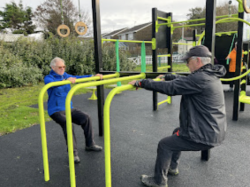
In our latest book WALK THIS WAY
We outline how it is possible to provide your body with it all needs on a simple daily walk and once you have mastered the basic strength moves, how to introduce bursts of speed, balance exercises and mindful moments – you will have the skills to do them at home too!
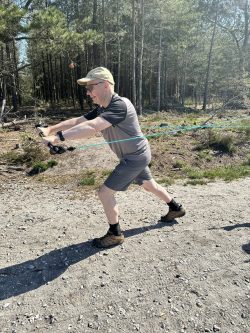 This leaflet produced by Age UK is also full of great ideas for ways to exercise at home Click HERE
This leaflet produced by Age UK is also full of great ideas for ways to exercise at home Click HERE
On October 5th WALX groups will be offering the chance to Discover how enjoyable it can be to make these changes as part of SILVER SUNDAY
Not convinced? These short drills from the book might inspire you to get started on improving strength and balance even if there is no WALX group nearby – you can practice them and follow the more challenging sequences as you start to notice the difference.
STRENGTH
There are 4 basic strength moves that can be done at home or when out on a walk – the one we feature here is one most of us know already – the good old SQUAT
This movement is so beneficial because it uses all the major lower body skeletal muscles providing strength and stability through to the core and spine. It’s also a good calorie burner and helps to keep you supple. Finally, it can be done pretty much anywhere so is great as your staple walking strengthener.
Note:- if you feel any discomfort in your lower back you may prefer starting with lunges as your main leg strengthener
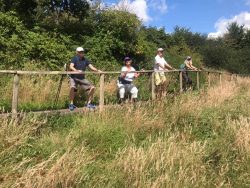 How to do them
How to do them
· The aim of a squat is to bend the knees, lowering body weight and ten standing back up slowly working the muscles in different ways on the up and down movements
· The key is to perform them in a controlled manner and not overdo it.
· How deep you go on a squat is mainly based on your personal hip, knee and ankle mobility so aim for as low as you can manage without taking your heels off the ground or allowing your bottom to drop lower than the knees – if that’s not very low, don’t worry just keep practising. A good 90 degree angle at the knee and thighs parallel to the ground is spot on if you can get there.
· Good form is to stand with feet at hip distance apart and both facing forward now keep the knees in line with each other as you lower your weight down towards the heels.
· Keep a good strong spine and note that your shoulders will come forward slightly as you push your bottom back.
· Make sure your feet are still anchored on the ground and the knees do not go over the toes
· Stand up taking the same time as you took to drop down as every movement is working one set of muscles.
Start with 10 if you can and work up to doing 10 then resting before building up to another 10 – you will be glad you did!
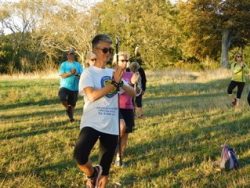 BALANCE
BALANCE
It is vital to take a holistic approach to all movement. Total body fitness includes the links between our eyes, brain, vestibular system and joints. All work together to keep us upright and mobile and ALL need stimulation and exercising to stay in good condition
Including a few balance exercises into your daily regime will make a huge difference and with simple things like closing your eyes on some drills, you are removing the signal from the visual system and putting greater emphasis on the signals from the vestibular system and from the receptors in joints and muscles (proprioception).
Start indoors and close to something to hold onto at first but build a habit that works for you. Some people advocate doing this when brushing teeth or waiting for the kettle to boil for instance. I think including balance into a walking sequence (especially where other elements are included) is the fastest and most effective way to make sure you do not skip them. Walk to a favourite spot and run through the sequence whilst fixing your eyes on something that is lovely BUT not moving!
Here is a short static balance sequence to practice – indoors or outside
· Stand on one leg – using you non dominant hand as the one that is ready to grab the worktop, chair or bench you are using to steady yourself if you wobble
· Start by just asking the leg to take the weight with the other leg bent at 90 degrees and arms by sides but not moving. If you need to, you can take them outwards at shoulder height.
· Take a minute to check in with the leg that you are standing on. Feel how the ankle and lower leg muscles adjust to this position.
· If you feel you can, challenge the leg more – raise your arms up or out to change the centre of gravity slightly.
· Change legs and repeat.
Adding more difficulty
· Stand on one leg as above but bend down and pretend to put a sock on the lifted foot!
· This can be done indoors and out and is a simple way to get the leg muscles used to your body weight shifting as you balance
· Of course, one way to remember to do it is to actually use it to pop your socks or shoes on every day
Add an extra challenge with these more advanced sequences
This is a more advanced sequence which is best performed outdoors where possible – you need more space and initially having something to grab if needed, is advised. Using poles is great as you can choose to use one or two and even lift them off the ground but be ready to use them if needed.
Static Balance sequence 1
· Stand on one leg – using you non dominant hand as the one that is ready to grab the rail, poles or bench you are using to steady yourself if you wobble
· Start by just asking the leg to take the weight with the other leg bent at 90 degrees and arms by sides but not moving. If you need to, you can take them outwards at shoulder height.
· Take a minute to check in with the leg that you are standing on. Feel how the ankle and lower leg muscles adjust to this position.
· Turn your head slowly to each side and possibly look upwards and see how that adds a small challenge to the process.
· Next try closing the eyes and holding the balance on one leg
Static balance sequence 2
· If you feel you can, challenge the leg more – raise your arms up or out to change the centre of gravity slightly.
· Next take the lifted leg through a series of movements that change your centre of gravity whilst keeping arms out to the sides
o Straighten the lifted leg and point the toes in front of you (keeping it off the ground if you can)
o Slowly take this straight leg out to the side – if it feels more comfortable, you can keep it bent
o Next take it behind you and point it backwards – lean slightly forwards if you can.
o Next bring it back to the raised start position before place back down
o Repeat with other leg
Find your local WALX group and ask them about total body walking for wellness and fitness sessions click HERE
For any information call the WALX HQ HUB on 0333 1234 540
Did you like this blog post?
Please click on a star to let us know if you liked this post. We'd love your feedback!
Average rating 5 / 5. Vote count: 2
No votes so far! Be the first to rate this post.
WORKING